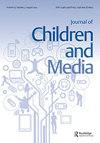Princesses and paupers: a content analysis of socioeconomic status in animated Disney films
IF 2.1
3区 心理学
Q2 COMMUNICATION
引用次数: 1
Abstract
ABSTRACT This paper examines depictions of SES in Disney animated films to learn about the stereotypes of different socioeconomic status (SES) groups that these films reinforce or dispel. As Disney films are frequently watched by children, and may have important developmental implications for the internalization of stereotypes. Sixty-one animated Disney films were coded f (323 characters). Characters were coded for their SES and various roles and behaviors. Results suggest low SES characters are underrepresented compared to the US population, and that Disney’s portrayal of SES both reinforces and contradicts stereotypes. IMPACT SUMMARY Prior State of Knowledge: Socioeconomic status is a significant factor in children’s development. As Disney media is often watched by children, the stereotypes of SES in Disney films are important to understand. Novel Contributions: Overall, this research indicates that low SES characters are underrepresented compared to the general US population and are more often racial minorities than mid and high SES characters. Few other characteristics examined, however, were significantly different based on SES. Practical Implications: Parents should be aware of and discuss the racial differences in socioeconomic status in Disney films with children. Furthermore, future research should examine the effect of depictions of socioeconomic status in children’s media on children’s stereotypes.公主与穷人:迪士尼动画电影社会经济地位的内容分析
本文考察了迪士尼动画电影中对SES的描述,以了解这些电影强化或消除的不同社会经济地位(SES)群体的刻板印象。由于迪斯尼电影经常被儿童观看,并且可能对刻板印象的内化具有重要的发展意义。61部迪士尼动画电影被编码为f(323个字符)。人物根据他们的社会地位和各种角色和行为进行编码。研究结果表明,与美国人口相比,低社会地位角色的代表性不足,迪士尼对社会地位角色的刻画既强化了人们对社会地位角色的刻板印象,又与之相矛盾。先前的知识状况:社会经济地位是影响儿童发展的重要因素。由于迪士尼媒体经常被儿童观看,因此了解迪士尼电影中对SES的刻板印象很重要。新颖的贡献:总的来说,这项研究表明,与美国总人口相比,低社会经济地位的人代表性不足,而且与中、高社会经济地位的人相比,低社会经济地位的人往往是少数民族。然而,很少有其他特征在SES的基础上有显著差异。实际意义:父母应该意识到并与孩子讨论迪斯尼电影中社会经济地位的种族差异。此外,未来的研究应探讨儿童媒体对社会经济地位的描述对儿童刻板印象的影响。
本文章由计算机程序翻译,如有差异,请以英文原文为准。
求助全文
约1分钟内获得全文
求助全文

 求助内容:
求助内容: 应助结果提醒方式:
应助结果提醒方式:


